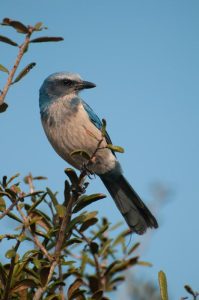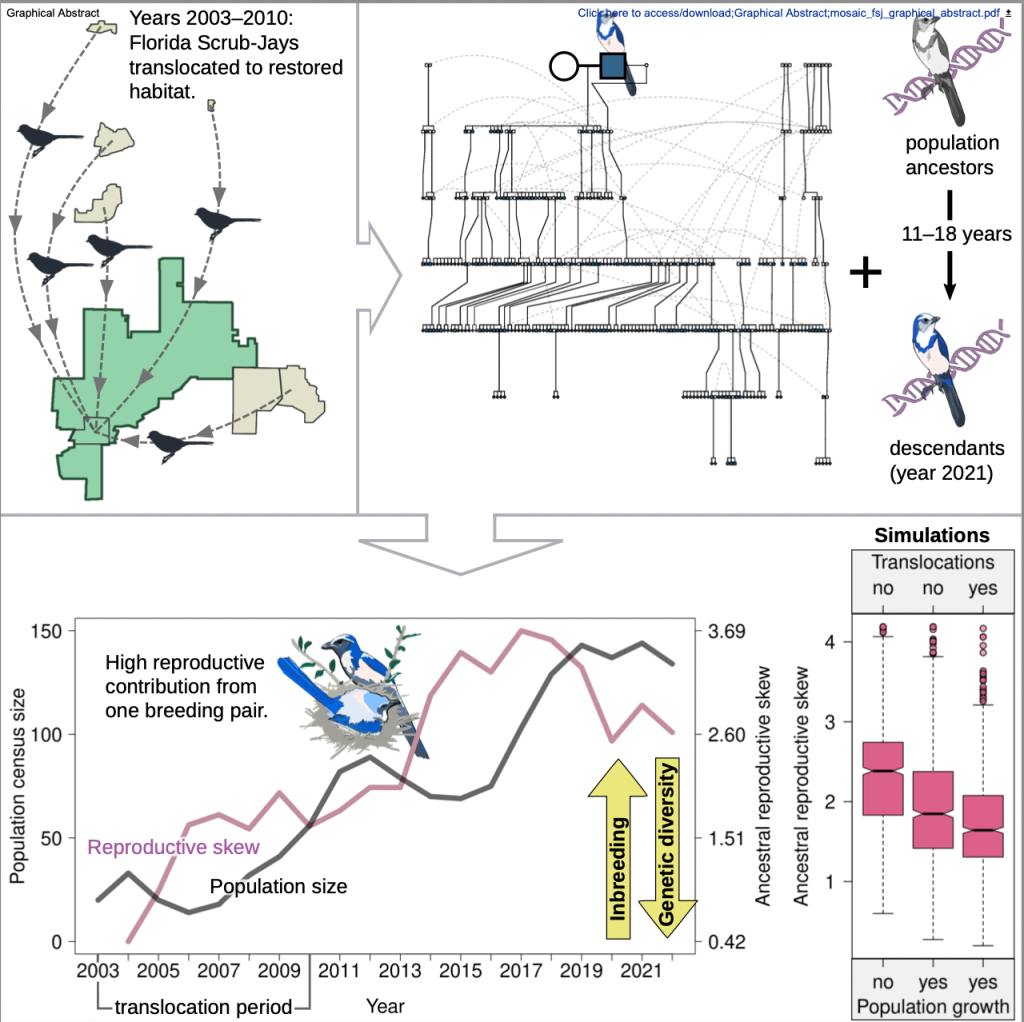
Conservation strategies are turning back the doomsday clock in threatened Florida Scrub-Jays – but not without caveats, a new study published in Current Biology shows.
In the early 2000s, conservationists proposed a plan to move isolated jays to a region comprising thousands of acres of restored habitat, home to a small community of 13 jays.
Translocation, where an organism is moved from one area to another, offers a means to prop up declining populations. Across an eight-year stretch from 2003 to 2010, 51 jays were relocated from fragmented and degraded habitats to a partially restored, contiguous region of scrubland called the M4 Core Region.
This strategy was proposed to thwart the compounding factors putting the Scrub-Jay at risk of extinction: inbreeding, decline in population size and reduced genetic diversity.
Analyzing genetic consequences of translocation
A team of researchers led by MSU and W.K. Kellogg Biological Station conservation geneticists Tyler Linderoth and Sarah Fitzpatrick analyzed decades’ worth of data, finding that translocations successfully bolstered population numbers but failed to overcome genetic erosion and inbreeding.
Decades of systematic tagging, field observations and genetic sequencing provided a nearly complete pedigree of the jays.
Leveraging this rich dataset, the researchers analyzed the genetic consequences of this strategy, sequencing the entire genomes of 87 jays sampled before, and several generations after, the first translocated jays were introduced to the M4 core region.
Results
This study shows, in unparalleled resolution, how demographic mechanisms, including births, deaths, emigrations and immigrations, influenced the genetic conditions of the M4 core region population.

“The only way to really have a pulse on population health is through both demographic and genetic monitoring, which can inform when and what conservation interventions are needed and how to adapt management accordingly,” said Linderoth, the paper’s lead author.
The researchers identified that although the population had rebounded, growing to ten-fold the original population size, genetic erosion persisted.
This population increase is critical for the continued survival of the species.
The dampened genetic diversity uncovered by the researchers is due to an uneven number of offspring produced per family line, a factor called reproductive skew.
Reproductive skew limits the effective population size: the members of a population who produce the next generation. A high effective population helps ensure robust genetic diversity, while low numbers indicate that genetic variation will decrease more rapidly.
A handful of genetic lines tracing back to mostly translocated jays now dominate the genetic make-up of the jay population, dampening genetic diversity. Importantly, however, the authors were able to show with simulations that translocation efforts effectively pumped the brakes on genetic erosion, despite failing to reverse it.
The authors note that translocations likely provided a net benefit to the population.
“Even though translocations did not completely prevent the loss of genetic diversity, they likely slowed the rate at which genetic diversity within the core population was lost and prevented inbreeding from being as high as it would have been otherwise,” Linderoth said.
The authors hope this study informs future conservation projects, highlighting the viability of translocations as a means for supporting at-risk populations.
“Even though translocations did not completely prevent the loss of genetic diversity, they likely slowed the rate at which genetic diversity within the core population was lost and prevented inbreeding from being as high as it would have been otherwise,” Linderoth said.
The authors encourage future projects to anticipate the negative impact of reproductive skew on translocation strategies and stress the importance of habitat management in supporting these efforts.
“Without sound habitat management and protection, translocations are likely doomed to fail. Even small areas of habitat can serve as important stepping-stones that facilitate migration and connectivity between populations,” Fitzpatrick said.
Project partnerships
The MSU researchers partnered with ecologists & co-authors Raoul Boughton, from The Mosaic Company, and Lauren Deaner of Flatwoods Consulting.
For over 20 years, ecologists from The Mosaic Company have monitored groups of Florida Scrub-Jays located 25 miles from the state’s west coast, monitoring changes at the demographic and genetic levels.
The conservation project first began with a partnership between The Mosaic Company, Reed Bowman — bird biologist at Archbold Biological Station, and pioneer of a 54-year Scrub-Jay monitoring program — and The United States Fish and Wildlife Service.
Raoul Boughton, lead ecologist at Mosaic and a collaborator on the study, explains the results detailed in this publication stem from a 30-year commitment to monitor and analyze the results of the mitigation translocation. “This publication highlights the genetic outcomes of this extensive experiment to date and provides critical information on how we may further improve the success of this project,” Boughton said.
~~~~~~~~~~~~~~~~~~~~
The original story was written by Caleb Hess.
~~~~~~~~~~~~~~~~~~~~

A legacy of conservation; a commitment to sustainability.
3700 E. Gull Lake Drive
Hickory Corners, MI 49060
(269) 671-5117
info@kbs.msu.edu